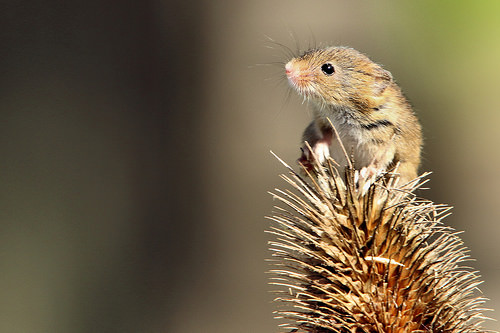Harvest mice are rodents like ordinary mice – but they are SO much more specialised.
And European Harvest Mice even have an adorably descriptive Latin name of Micromys minutus!*
Yes, they are rodents and have their wonderfully sharp incisors for chewing grain and seed cases off of things – but they have nowhere near the same power for damage – or the inclination to do so either.
They also don’t have much of a penchant for becoming scavengers – unlike the house mouse (Mus musculus) or brown rats (Rattus norvegicus) which will eat just about ANYTHING.
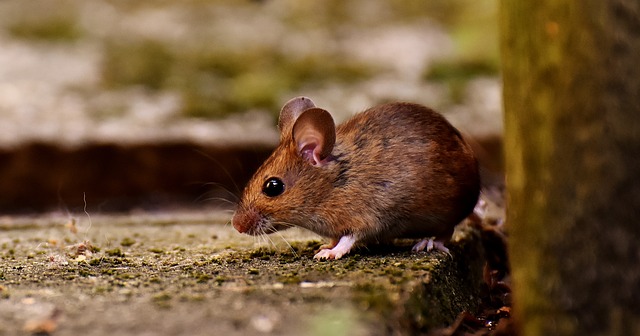
Harvest mice still have a wild touch to them and favour natural foods and plants, berries and insects over man-made foods and treats.
*European Harvest Mice are genetically very different to US Harvest Mice which are from a completely different rodent family. They are from the genus Reithrodontomys and there are around 20 different species of them across the continent.
Keeping Harvest Mice as Pets
If you are keeping your harvest mice as pets – you need to be able to replicate this diet to a greater extent – and this involves variety. Harvest mice in the wild have the farmers field, ditches, hedges and shrubs to forage for their food in – and you need to be able to offer something similar if you want your pets to stay in good health.
Unlike most pet rodents such as gerbils and guinea pigs – harvest mice don’t really eat fresh fruit and vegetables from the shops – it just isn’t in their mindset. There are a few such things that they will nibble on, but these are very much only things that you could find sitting in a field anyway like sweetcorn and kale . However slices of carrot, and mangoes just don’t appeal as much.
So, to make sure your little ones get the right diet – keeping harvest mice means a bit of experimentation – and either a lot of online shopping or a new hobby of plant identification and walking in the countryside?
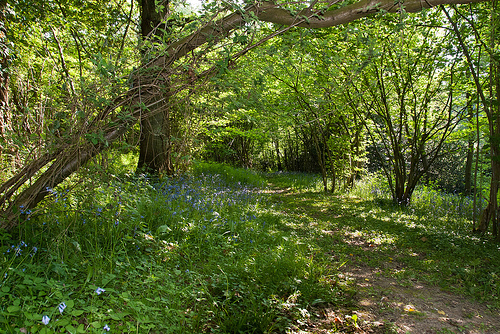

How Harvest Mice Eat:
Now I know this might seem obvious – like, with their mouths – but harvest mice are very adapted to eating on the hoof – or should I say – plant.
By this I mean that with their agile body, versatile limbs and prehensile tail – they very much enjoy eating plants and seeds as they would find them in the wild. Upright and in tussocks.
So when you are grabbing foods from the wild or in a store – look for those in a natural state – the longer and bushier the better. I often tie together sticks, twigs and stems with twine and insert into the enclosure – that was they can all feast on it at the same time at different heights without all squabbling over a dish waiting their turn.
It also looks much better – like harvest mouse TV.
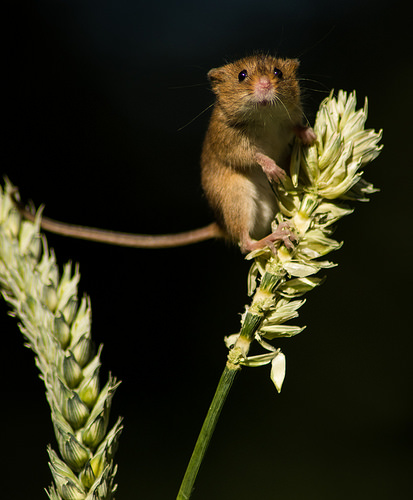

Also, with foods, harvest mice don’t really ‘dig’ for food. They will eat off the surface of the ground and may scuffle around in a light litter, but anything more than a centimeter below the current surface – and they won’t ever see it again.
Feeding them of the floor by scatter feeding isn’t a good technique for these specialised mice – so if you have foods to offer off of a plant or stem, then use a large shallow dish – especially with fresh or moist foods. This way it can be reached without digging and everyone can get access.
Food dropped directly onto the floor should be only given in small portions and should be something that isn’t moist and which can’t become moist. Mouldy leaf litter is not something you want in your enclosure – but is something you will get regularly if you don’t use a dish.
Seed cases and chewed plants dropped from higher up in the enclosure will form a layer on even the driest sand substrate, so beware of giving it the chance to go mouldy. Harvest mice seem oblivous to their tails going in the water bowl* and drag the water all over the place.
*Most harvestmice struggle to use a water bottle as their tiny tongues can’t lift up the ball bearings inside to release the water – we have tried several types and it is relly hit and miss – and harvest mice need a lot of water – you can lose them fast if they can’t access water for 24 hours.
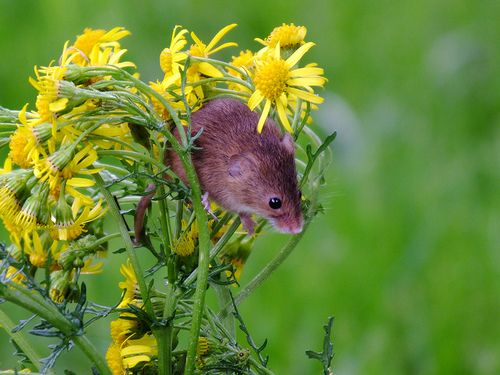

Natural Foods For Harvest Mice:
It would make sense if you stuck to the foods around where you are anyway – not only for ease of collection – but also as it is the preferred food for your mice anyway. Even though buying from a store can be fun!
A walk through the countryside near your home (away from roads or other forms of pollution including chemical sprays by farmers) could easily haul you in a weeks food or more for your family group.
However, if you follow through the seasons – and plan ahead – you can really make the most of nature.
Assuming you are walking late summer and into fall, anything with seed heads can be given fresh – like cow parsnip (they love these) and other umbellifers (although watch out for the sap if picking fresh as it can irritate human skin) – but also an excess of these same heads kept hanging upside down in a well-ventilated shed could last you well into the winter when these things just aren’t available naturally.
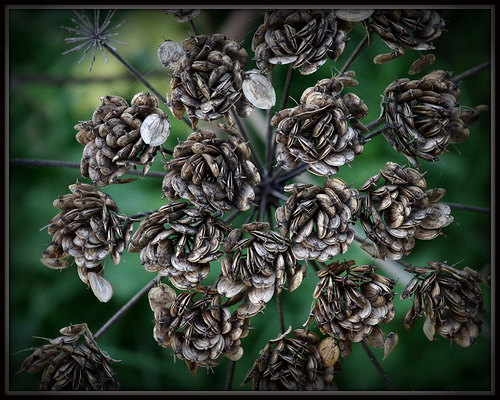

Start collecting berries such as hawthorn and elder which can be offered fresh too – but are much preferred when dried – and less than a saucepan full this past Fall has lasted me through until Spring (keeping the family very happy).
Things like wild rose can be gathered across the season – starting with the petals. All flowers drop their petals after they have been pollinated – and the seeds start to develop after this inside the flower head. So if you can carefully collect the petals, which can be given fresh or dried for storage, just after pollination – it won’t affect the seeds. These seeds by late Fall – are encased in shiny rose hips (below image) – also very tasty either fresh or dried for storage. Double whammy.
Collecting twigs from oak, hazel, ash, willow and hawthorn are all welcomed in the harvest mouse larder – especially if they have bugs or lichen on them – all totally natural to your mice.
Of course these twigs can be given either with or without the leaves on them depending on your season, but the leaves will fall off the branches in your enclosure as they die, making either a bit of a mess or a lovely rich leaf litter depending on how you look at it?
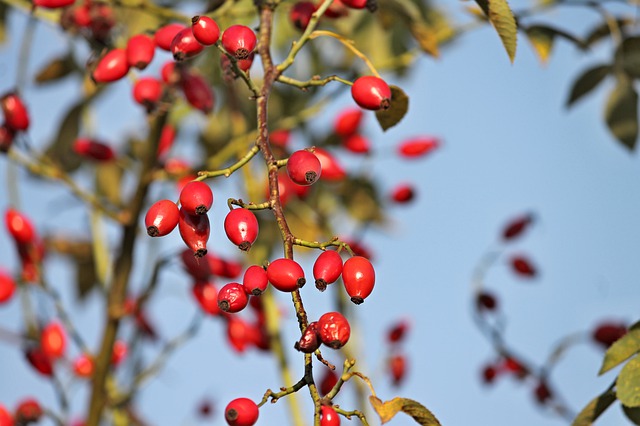
Growing Your Own Food For Harvest Mice:
Seed crops from the garden can also be harvested for the harvest mice such as ornamental roses, artichoke flowers, nasturtiums, chamomile, echinacea, brassica and carrot flowers, marigolds and many more ‘native’ plants.
You can also grow all your own specialist seeds crops in your garden or in pots – such as millet, sunflowers, plantain, pumpkins and squash (for the seeds mainly – you get to eat the flesh!), wheat and oats, etc. Basically anything a farmer can grow – you can too (just without the whole tractor thing).
And you can buy seeds for all sorts of grasses too – which they will just love – there is no limit.
Other garden delights can include sweetcorn, baby sweetcorn (a particular favourite of my mice) raspberries, wild strawberries, lavender and thistles although they really aren’t too fussed about a lot of ‘bits’ of veg I put in the enclosure – they only seem to like whole foods?
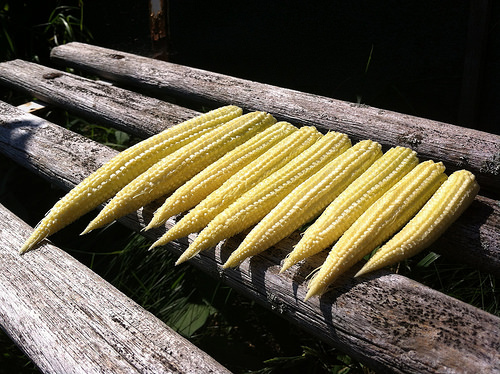

Do Harvest Mice Eat Live Food?
Very much so, and in fact it is part of their natural diet – they really need the protein and energy it gives them.
You can catch natural wildlife if you want, such as small worms, grasshoppers, caterpillars, flies and crickets (however there is always a risk of contamination or parasites), or you can buy them in from your local reptile store or online for home delivery – yes they really do post live insects to our house!
Things like larval, pupating or adult waxworms; or, pupating mealworms and adult mealworm beetles go down a treat (larval mealworms burrow out the way – centre in below image – and dried mealworms just aren’t juicy enough). We grow our own mealworms now, that was so we always have them on hand at the preferred ‘pupa’ life stage (left in image below).
It has been said that they will also eat raw or cooked meat if given to them – such as bits of roast chicken. We haven’t tried this ourselves yet, and we would be worried that if they didn’t eat it all we would have to clean out the entire enclosure if it started to stink the place up. I mean there are loads of hiding places in my natural set-ups?
Perhaps only feed this just prior to a clean out?
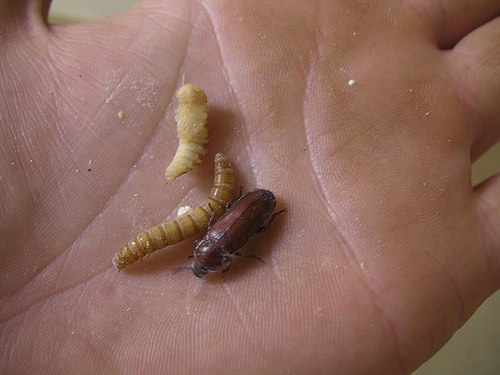

They do however, also eat each other if they die – this is why people keeping large, relatively natural enclosures often don’t find any dead harvest mice. They are just too good a source of protein to waste…
Do Harvest Mice Eat Fruit And Vegetables?
Well, the short answer is yes they will – but they don’t really go for it like with seeds and live food.
Apart from sweetcorn and mini sweetcorn, we haven’t really seen them jump on anything veg-like. They have eaten curly kale one time, and they have chewed on strawberries, raspberries, blackberries, apple and butternut squash – but it wasn’t straight away. We had left it in there for a day or so before we saw teeth marks on it.
Best Commercial Harvest Mouse Food:
Most people will look to the bulk of their harvest mouse food from their local pet stores or pet sections of larger stores – which is fine for the most part.
Any of the smaller bird seed mixes – such as finch, canary and budgie – are perfect mixed together for a stock feed. Larger bird seeds contain larger pieces of course – which aren’t the best – and most parrot foods contain chilli pepper – which is definitely a no-no for your mice.
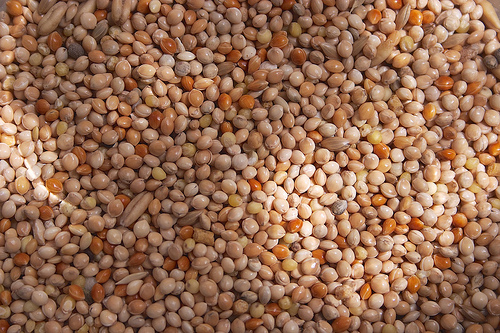

There are also one-off seeds that aren’t always in the mixtures like Niger seed and hemp which you might want to order in separately to make a bit of a change – but most bird seeds contain things you might not imagine like linseed, safflower, white millet and oil seed rape – and most of them are almost the same anyway even if they appear superficially different – so do read the labels before buying loads of different mixes and having bags of it all over the place.
Wild bird seeds are great too as they offer a variety of grains and something called ‘mixed corn’ is very popular (even if it doesn’t contain any sweet corn) including wheat, barley and oats.
Small animal foods aren’t as good as bird mixes as they have less seeds – but a few are quite niche and so can cater for the harvest mouse’s needs – ie – tiny pieces, variety and whole – such as mouse or dwarf hamster food. Always go for the muesli types – as the extruded versions (where all the food is unidentifiable and brightly coloured as below) aren’t whole foods, are therefore less appealing and might not be eaten.
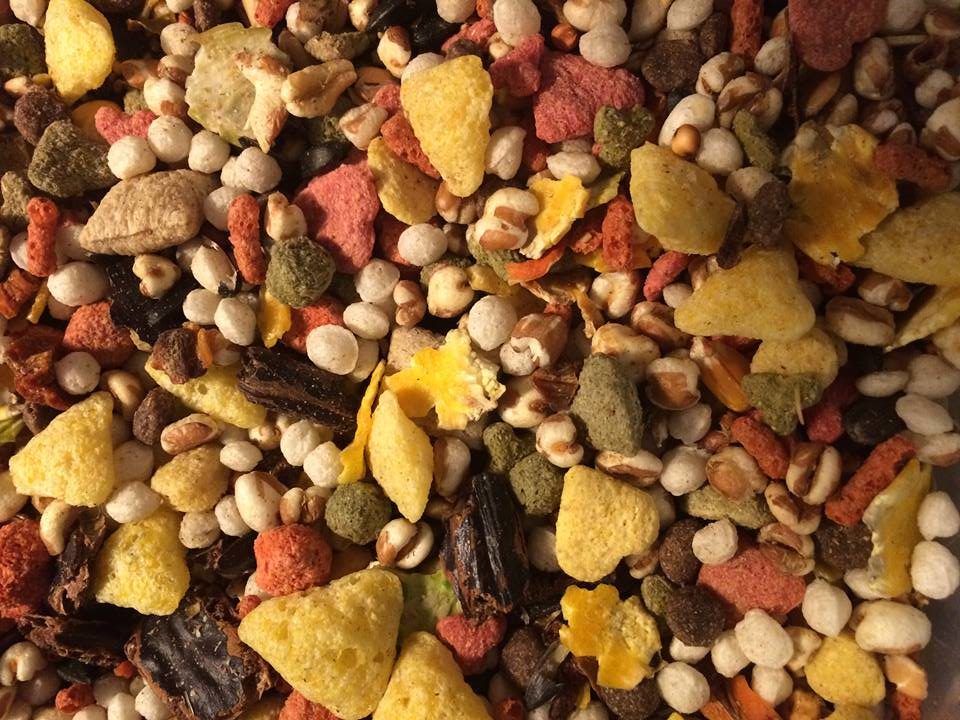
And when you have an animal that needs to eat up to 30% of its own body weight every day to be healthy, you really want to give it food it can eat…
Also, the colder the harvest mice are, the more they need to eat – so make sure that your harvest mouse enclosure is always kept in a warm room or it has a reptile heat mat under at least a quarter of its base. Otherwise they will be eating food just to stay warm rather than to have fun!
So, keep a supply of fresh sweet corn and grass to hand and learn how to dry petals, leaves and berries and you should be great!
